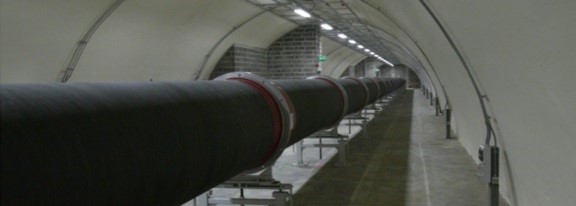CEE Seminar: Co-spectral Budgets Link Energy Distributions in Eddies to Bulk Flow Properties in Hydrology & Micrometeorology

Theodore S. Coile Professor of Hydrology & Micrometeorology
Civil & Environmental Engineering
Duke University
Abstract: Connections are explored between spectral descriptions of turbulence and the mean velocity profile in wall-bounded flows using a budget for the co-spectral density. The co-spectrum is derived using a standard model for the wall normal velocity variance and a linear Rotta-like return-to-isotropy closure modified to include the isotropozition of the production for the pressure-strain effects. The approach provides a relation between well-established constants such as the von Karḿan and Kolmogorov constants, and the Rotta constant known to vary with the flow configuration. Depending on the choices made about small-scale intermittency corrections, the logarithmic mean velocity profile or a power-law profile with an exponent that depends on the intermittency correction are derived thereby offering a new perspective on a long-standing debate about the shape of the mean velocity profile in the equilibrium region1. The twice-integrated co-spectral budget with respect to scale and depth is then used to explain the variation in the friction factor with Reynolds number in smooth pipes2 with attention to the switch from power-law (Blasius scaling) to log-law (Colebrook’s formula). A general discussion on how to link the ‘microstates’ of eddies (i.e. energy distribution in eddies) to macroscopic flow properties used in operational hydrology and micrometeorology (i.e. bulk flow relations such as Manning’s formula, Monin-Obukhov similarity theory, stably stratified flow properties, Strickler scaling for roughness elements, etc….) is also featured.


Ludwig Prandtl (1904) with his fluid test channel (left). Center for International Cooperation in Long Pipe Experiments (right).
References:
1Katul, G.G., A. Porporato, C. Manes, and C. Meneveau, 2013, Co-spectrum and mean velocity in turbulent boundary layers, Physics of Fluids, 25, 091702;
2Katul, G.G. and C. Manes, 2014, Cospectral budget of turbulence explains the bulk properties of smooth pipe flow, Physical Review E, 90, 063008
Collaborators: C. Manes, A. Porporato, E. Bou-Zeid, D. Li, M. Chamecki, and C. Meneveau
Bio: Gabriel G. Katul received his B.E. degree in 1988 at the American University of Beirut (Beirut, Lebanon), his M.S. degree in 1990 at Oregon State University and his Ph.D degree in 1993 at the University of California, Davis. He is currently the Theodore S. Coile Professor of Hydrology and Micrometeorology at the Nicholas School of the Environment and the Department of Civil and Environmental Engineering at Duke University.
He served as an associate editor for Advances in Water Resources (1998-2014), Boundary Layer Meteorology (1998-present), Water Resources Research (2004-2009), the Vadoze Zone Journal (2000-2003) and served as one of the four editors-in-chief for Advances in Water Resources (2011-2014). He was a visiting fellow at the Commonwealth Science and Industrial Research Organization (Australia) in 2002, at University of Helsinki (Finland) in 2009 and a FulBright-Italy Distinguished Fellow at Politecnico di Torino (Itay) in 2010. He also served as a visiting fellow at École polytechnique fédérale de Lausanne (Switzerland) in 2013 and at Nagoya University (Japan) in 2014. He received several honorary awards, including an honorary certificate by La Seccion de Agrofisica de la Sociedad Cubana de Fisica in Habana in 1998, an editor’s citation for excellence in refereeing from the American Geophysical Union in 2008, and the Macelwane medal in 2002, the same year he became a fellow of the American Geophysical Union. In 2012, he received the Hydrologic Science Award from the American Geophysical Union. He served as the Secretary General for the Hydrologic Science Section at the American Geophysical Union (2006-2008). Research in Katul's lab focuses on micro-meteorology and near-surface hydrology with emphasis on heat, momentum, carbon dioxide, water vapor, ozone, particulate matter (including aerosols, pollen and seeds) and water transport in the soil-plant-atmosphere system as well as their implications to a plethora of hydrological, ecological, atmospheric and climate change-related questions.
Share
Upcoming Events
-
MSE 298 Seminar: Translational Neuroelectronics
-
CBE Seminar: Water Structure and Computational Design of Water-mediated Solute-surface Interactions
-
CALIT2 Distinguished Lecture: Strategic Directions for Electronics Packaging
-
MSE 298 Seminar: Science-Based Advanced Manufacturing of Metals and Alloys
-
EECS Seminar: Transient Electronics – From Bioelectronic Medicines to Environmental Monitors
